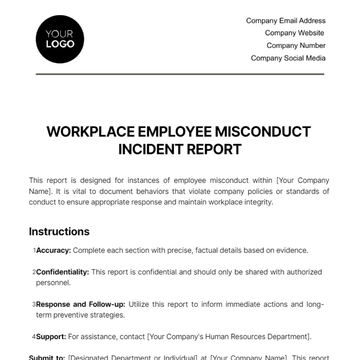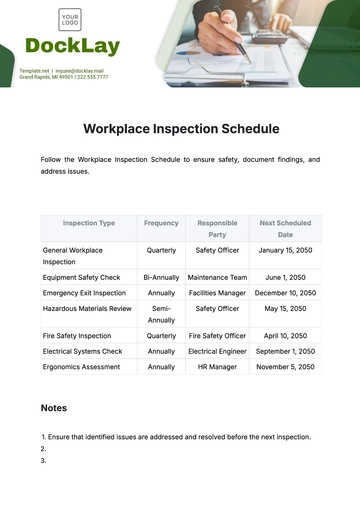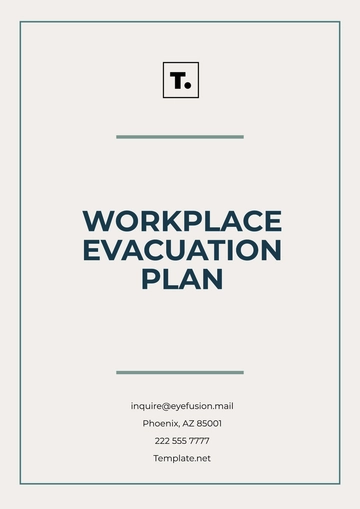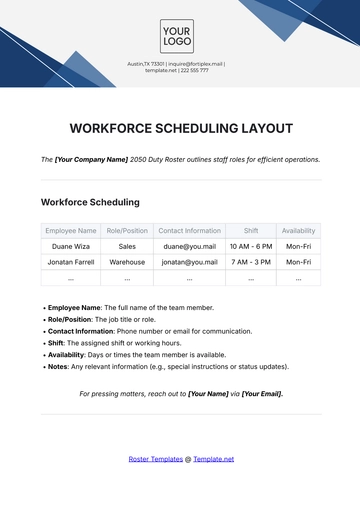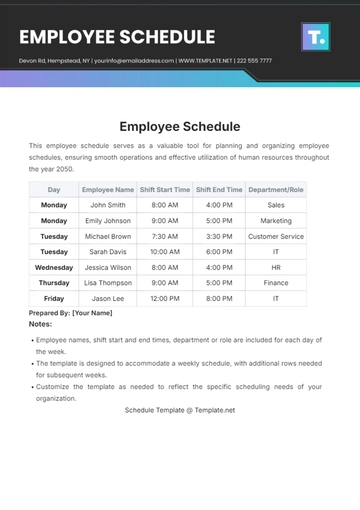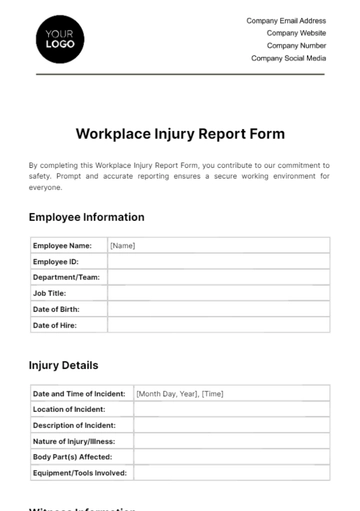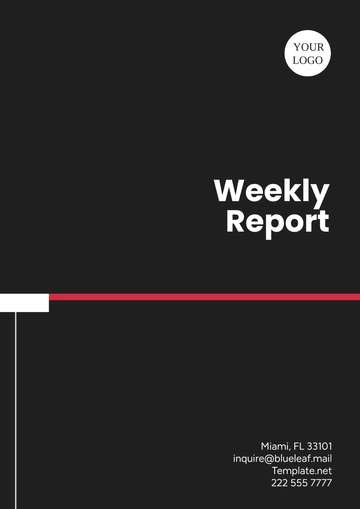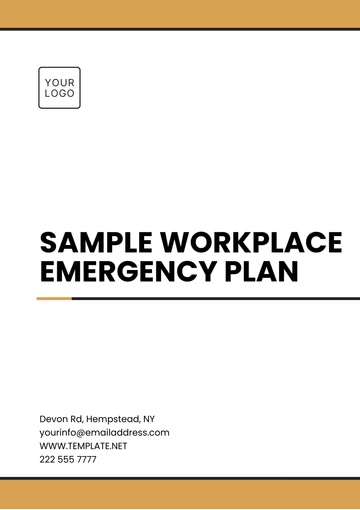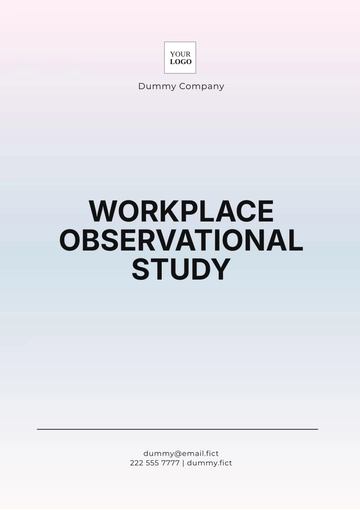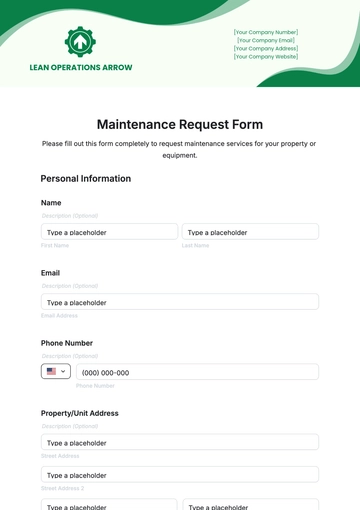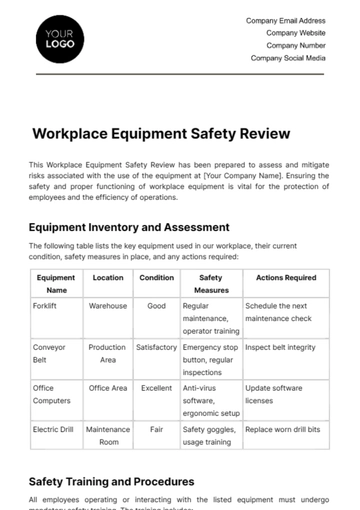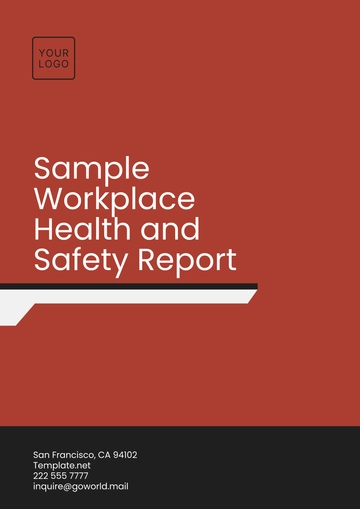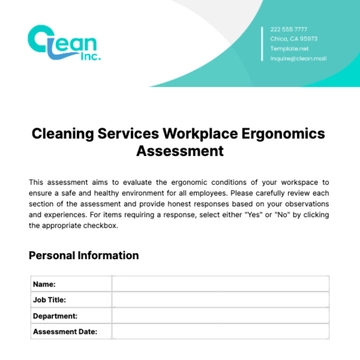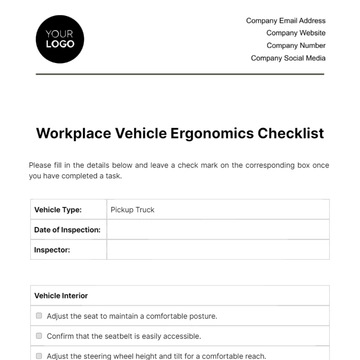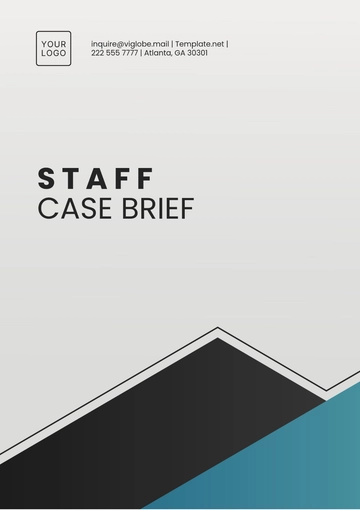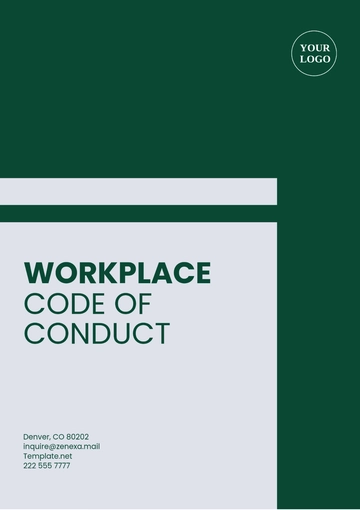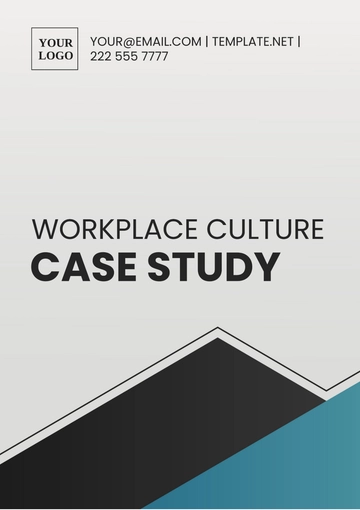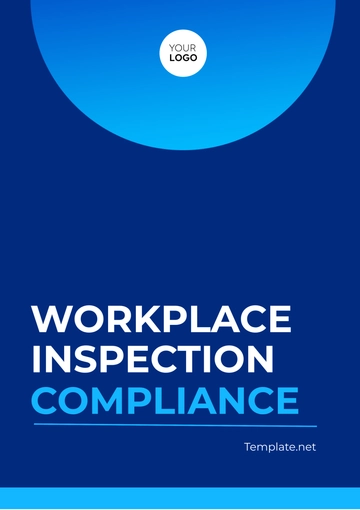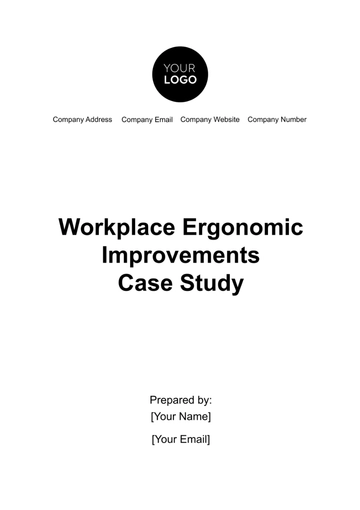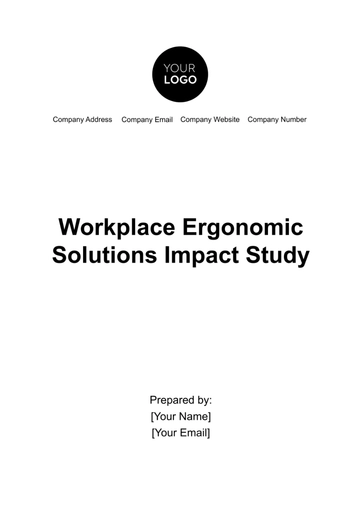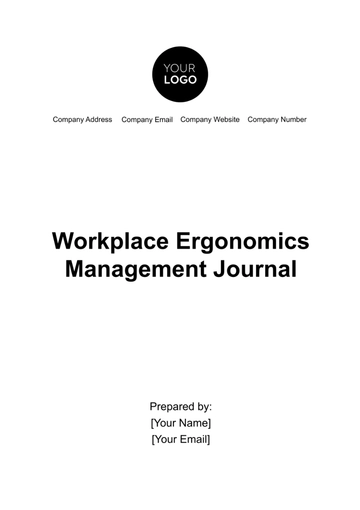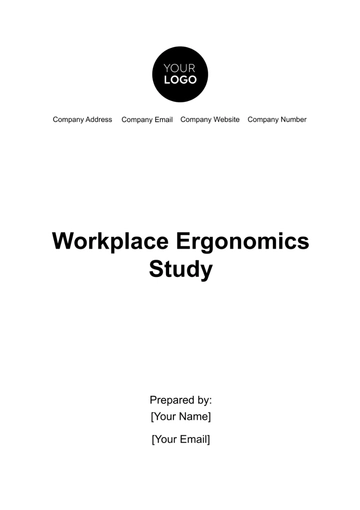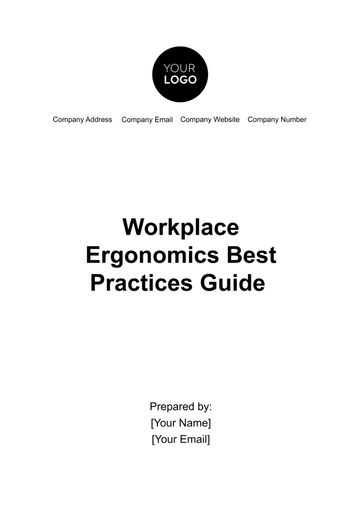Free Workplace Incident Study
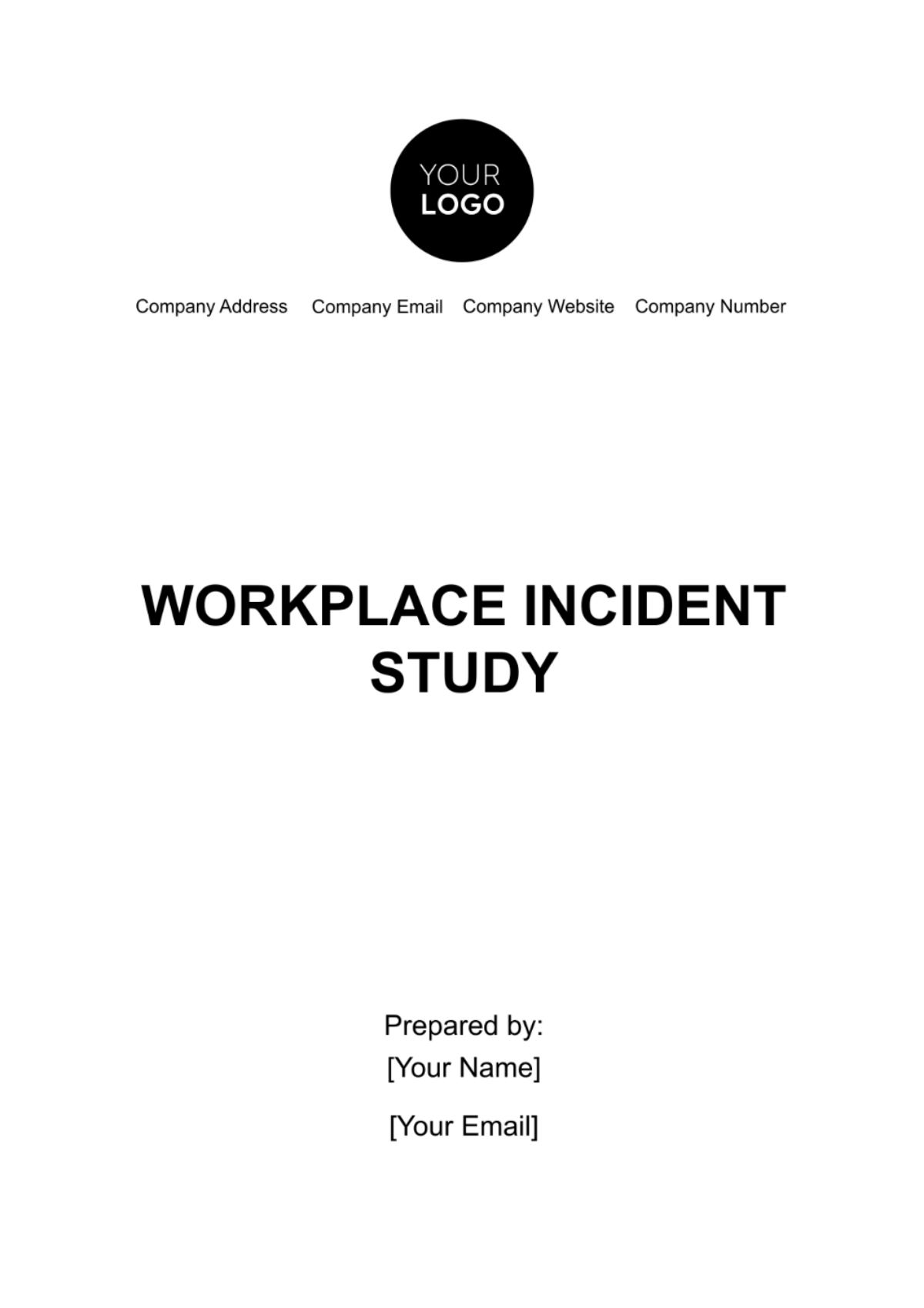
1. Executive Summary
The Workplace Incident Study Report provides a thorough examination of recent workplace incidents at [Your Company Name]. Within this report, we delve into the specifics of each incident, conduct a comprehensive impact analysis, uncover the root causes behind these events, and present actionable recommendations for ensuring the safety of our workforce and preventing future incidents.
In this analysis, we have meticulously documented incident details, including dates and locations, to offer a clear picture of each event. Furthermore, our impact analysis dissects the financial, operational, and reputational consequences these incidents have incurred. This information is crucial for understanding the full scope of the challenges we face.
Delving deeper, our root cause analysis identifies the contributing factors that led to these incidents. By pinpointing the underlying causes, we can implement effective corrective measures that target the root issues.
Finally, this report arms us with a comprehensive set of recommendations. These actionable insights encompass immediate actions to address urgent concerns and long-term preventive measures aimed at fortifying our safety protocols.
By adopting these recommendations, [Your Company Name] can enhance workplace safety, minimize financial setbacks, and ensure the continuity of our operations. Our commitment to safety is unwavering, and this report serves as a roadmap for a safer and more secure future for all employees.
2. Introduction
2.1 Purpose of the Study
The primary objective of this study is to comprehensively assess workplace incidents within [Your Company Name]. By doing so, we aim to enhance the overall safety within our organization. Furthermore, this study is designed to identify strategies to reduce the financial impact of incidents and minimize the operational disruptions they may cause. Through a careful examination of these incidents, we seek to strengthen our commitment to the well-being of our employees and the sustainability of our operations.
2.2 Scope of the Study
The scope of this study is defined by the temporal boundaries from [Month Day Year] to [Month Day Year], encompassing all workplace incidents occurring during this timeframe within [Your Company Name]. This inclusive approach allows us to capture a holistic view of incidents and their effects on our organization. By examining incidents within this specified period, we can develop insights and recommendations that are relevant to the recent challenges our company has faced, ensuring that our actions are grounded in current realities and experiences.
3. Methodology
3.1 Data Collection
Our data collection process was multifaceted, involving a meticulous review of incident reports, in-depth interviews with involved parties, and a thorough examination of pertinent documents. Incident reports provided us with a structured account of each event, while interviews allowed us to gain valuable firsthand insights from individuals directly involved or witnesses. Additionally, the scrutiny of relevant documents, such as safety records and procedures, supplemented our understanding of the incidents. This multifaceted approach ensured that we obtained a comprehensive dataset that formed the basis of our analysis.
3.2 Data Analysis
The data we collected underwent rigorous analysis to uncover essential patterns, identify root causes, and quantify the financial impact of each incident. Our analytical process involved a meticulous examination of incident timelines, sequences, and correlations. By scrutinizing this data, we were able to discern recurrent patterns that shed light on the underlying causes of these incidents. Furthermore, we applied financial modeling and cost attribution techniques to quantify the financial implications, providing a clear picture of the economic toll. This data analysis phase serves as the cornerstone of our recommendations, as it enables us to develop targeted and effective strategies for mitigating future incidents.
4. Incident Overview
Incident Overview," provides a detailed account of the workplace incident under scrutiny, offering critical insights into its chronology, location, and the circumstances that surrounded it. A comprehensive understanding of these incident-specific details is crucial for grasping the broader context and ramifications of each event.
In this example, we delve into the specifics of the incident, beginning with the date it occurred. The incident's location is documented to pinpoint the geographical context. Most importantly, a thorough and factual description of the incident is provided, offering a clear account of the events that transpired. This information is pivotal for subsequent analyses, including impact assessments and root cause investigations, as it forms the foundation for understanding the incident's scope and implications.
Incident Date: [May 15, 2023] |
Incident Location: [Warehouse B], [Your Company Name] |
Incident Description |
On [Date], at approximately [Time], a workplace incident occurred at Warehouse B of [Your Company Name]. The incident involved a forklift operator, [Name], who accidentally collided with a storage rack containing pallets of materials. This collision led to the toppling of several pallets, causing damage to the stored goods and posing a potential safety hazard. Immediate responses included the evacuation of the affected area, and [Name] received prompt medical attention for minor injuries sustained during the incident. Eyewitnesses reported hearing a loud crash, and the initial impact assessment revealed property damage estimated at [$000.00]. Further investigation into the root causes and preventive measures is underway. |
5. Impact Analysis
In this impact analysis, we have quantified the financial consequences of the incident in various categories. Property damage is estimated at [$000.00], covering the cost of repairing or replacing damaged assets. Medical expenses incurred due to injuries related to the incident total [$000.00], encompassing medical treatment and related costs. Lost revenue accounts for [$000.000], reflecting the income loss resulting from operational disruptions. Lastly, legal costs amount to [$000.00], comprising expenses related to legal consultations and potential settlements. The total financial loss incurred as a result of the incident stands at [$00.000]. These figures provide a comprehensive overview of the incident's financial implications, aiding in decision-making and resource allocation for corrective actions.
5.1 Financial Impact
5.2 Operational Impact
The incident caused significant operational disruptions. Production was halted for [X] hours, resulting in a delay in fulfilling customer orders. Additionally, employee morale was affected, leading to a decrease in productivity. The estimated cost of operational disruptions is $[Operational Impact Amount].
5.3 Reputational Impact
The incident has had a notable impact on our company's reputation. It was reported in local news, which raised concerns among our customers and partners. This negative publicity has led to a loss of trust, affecting our brand image. Rebuilding our reputation is a priority, and it may require significant resources and time.
6. Root Cause Analysis
This chapter delves into the meticulous examination of the incident's contributing factors and presents the key findings obtained through the root cause analysis:
Contributing Factors |
|
|
|
|
|
|
Findings |
Through a comprehensive root cause analysis, several critical findings have emerged: |
|
|
|
|
|
|
These findings serve as the basis for developing effective corrective measures and strategies for incident prevention.
7. Recommendations
Based on the comprehensive analysis of the incident, as detailed in previous chapters, the following recommendations are presented:
7.1 Immediate Actions
Reinforce Training Programs: Implement immediate and targeted training programs to ensure all employees receive proper training in forklift operation and safety protocols.
Enhance Signage and Warnings: Improve signage and warning systems within Warehouse B to enhance visibility and prevent potential collisions.
Workload Management: Review and optimize workload management to reduce the pressure on employees and discourage rushed tasks
Maintenance Protocols: Establish a rigorous maintenance schedule for all equipment, including routine checks for the forklift involved in the incident.
Supervision and Monitoring: Strengthen supervision and monitoring of forklift operations, ensuring adherence to safety procedures.
Enhanced Communication: Foster a culture of open communication among warehouse personnel to promptly address safety concerns and share critical information.
7.2 Preventive Measures
Ongoing Training: Implement ongoing training and certification programs to continually improve employees' skills and safety awareness.
Safety Audits: Conduct regular safety audits and inspections to identify potential hazards and mitigate risks proactively.
Technology Integration: Explore the integration of safety-enhancing technology, such as proximity sensors and automated warning systems, into the workplace.
Standard Operating Procedures: Develop and enforce comprehensive standard operating procedures (SOPs) for all critical tasks within the organization.
Incident Reporting System: Implement an efficient incident reporting system, encouraging employees to report near misses and potential hazards.
Safety Culture Promotion: Promote a safety-first culture through awareness campaigns, recognition programs, and employee engagement.
These recommendations, when meticulously executed, will not only address the root causes identified but also establish a robust framework for preventing future workplace incidents. The commitment to safety is paramount, and the proactive adoption of these recommendations will contribute significantly to a safer and more secure working environment for all employees at [Your Company Name].
8. Action Plan
The Action Plan chapter outlines the practical steps that will be taken to implement the recommendations presented in the previous chapter. It specifies who is responsible for each action item, the timelines for completion, and the allocated budget to facilitate efficient execution.
8.1 Responsible Parties
Action Item | Responsible Party |
Safety Training Programs | Safety Training Department |
Signage and Warnings Improvement | Facilities Management |
Workload Management Review | HR Department |
Equipment Maintenance Schedule | Maintenance Team |
Supervision and Monitoring Enhancement | Operations Supervisor |
Communication Improvement Initiatives | Communication Committee |
8.2 Timelines
Action Item | Timeline |
Safety Training Programs | [6 hours per week] |
Signage and Warnings Improvement | |
Workload Management Review | |
Equipment Maintenance Schedule | |
Supervision and Monitoring Enhancement | |
Communication Improvement Initiatives |
8.3 Budget Allocation: Amount [$000.00]
Action Item | Budget Allocation [$000.00] |
Safety Training Programs | [$300/employee] |
Signage and Warnings Improvement | |
Workload Management Review | |
Equipment Maintenance Schedule | |
Supervision and Monitoring Enhancement | |
Communication Improvement Initiatives |
This structured approach ensures that each action item is clearly assigned, has a defined timeline for completion, and is allocated the necessary budget for implementation. It serves as a comprehensive roadmap to turn recommendations into actionable improvements for a safer and more secure workplace environment at [Your Company Name].
9. Monitoring and Review
9.1 Key Performance Indicators
KPI Description | Measurement Metric | Target Value | Frequency of Measurement |
Incident Frequency | Number of Incidents | <5 per month | Monthly |
Incident Severity | Severity Rating (1-5) | <2 (Low) | Quarterly |
Response Time | Minutes from Alert to Action | <15 minutes | Real-time |
Employee Training Completion | Percentage of Employees | 100% | Annually |
Safety Compliance | Compliance Rate | 95% or higher | Monthly |
These defined KPIs will enable us to systematically measure and assess the progress and effectiveness of our incident response plan. Incident frequency and severity help us gauge the overall safety of our workplace, while response time measures our efficiency in addressing incidents promptly. Employee training completion ensures that our workforce is well-prepared, and safety compliance measures adhere to established safety protocols. Regular monitoring of these KPIs will facilitate data-driven decision-making and continuous improvement in our safety measures at [Your Company Name].
9.2 Review Frequency
The review frequency specifies how often the incident response plan will undergo a comprehensive evaluation. Regular reviews are essential to ensure that the plan remains up-to-date, relevant, and aligned with changing circumstances. The review frequency will be determined by [Your Company Name]'s specific needs but should typically include periodic assessments, such as monthly, quarterly, or annual reviews, to maintain the plan's effectiveness. These reviews will involve all relevant stakeholders, allowing for adjustments and improvements as necessary to enhance workplace safety continually.
10. Conclusion
This comprehensive Workplace Incident Study Report serves as a pivotal resource in our commitment to workplace safety and continuous improvement. Through meticulous analysis, we have dissected recent incidents, identified their root causes, and presented actionable recommendations and an implementation plan. With a structured approach encompassing training, signage improvements, workload management, maintenance, supervision enhancements, and communication initiatives, we are poised to enhance safety measures at [Your Company Name]. Furthermore, our defined Key Performance Indicators and regular review frequency will ensure the sustained effectiveness of our incident response plan. We acknowledge that the journey to a safer workplace is ongoing, and our unwavering dedication to safety, guided by this report, will enable us to mitigate risks, protect our workforce, and fortify our reputation as a responsible and safety-conscious organization.
11. Appendices
[Include any additional data, charts, or documents relevant to the study.]
For inquiries or further information, please contact:
[Your Name]
[Your Company Email]
[Your Company Website]
[Your Company Address]
[Your Company Number]
- 100% Customizable, free editor
- Access 1 Million+ Templates, photo’s & graphics
- Download or share as a template
- Click and replace photos, graphics, text, backgrounds
- Resize, crop, AI write & more
- Access advanced editor
Introducing Template.net's Workplace Incident Study Template, a comprehensive solution for analyzing workplace incidents. Fully customizable and editable in our Ai Editor Tool, this template empowers businesses to investigate incidents thoroughly. Gather vital data, assess root causes, and implement preventive measures with ease. Simplify incident analysis and enhance workplace safety standards with our user-friendly platform.
